
Rabbit Anti-SNAIL + SLUG antibody
SNAIL+SLUG; dJ710H13.1; Protein sna; Protein snail homolog; SLUGH2; SNA; Sna protein; SNAH; SNAI1; Snail homolog 1 (Drosophila); Zinc finger protein SNAI1; SNAI1_HUMAN; Protein snail homolog 1; dJ710H13.1; SNAIL; SNAIL1; Protein sna; Neural crest transcri
View History [Clear]
Details
Product Name SNAIL + SLUG Chinese Name 锌指转录因子Slug+SNAIL抗体 Alias SNAIL+SLUG; dJ710H13.1; Protein sna; Protein snail homolog; SLUGH2; SNA; Sna protein; SNAH; SNAI1; Snail homolog 1 (Drosophila); Zinc finger protein SNAI1; SNAI1_HUMAN; Protein snail homolog 1; dJ710H13.1; SNAIL; SNAIL1; Protein sna; Neural crest transcription factor Slug; Protein snail homolog 2; Slug (chicken homolog) zinc finger protein; Slug homolog zinc finger protein; Slug zinc finger protein; SLUGH 1; SLUGH; SLUGH1; SNAI 2; SNAI2; SNAI-2; SNAI2_HUMAN; Snail 2; Snail homolog 2; Snail2; Snail-2; WS 2D; WS2D; Zinc finger protein SLUG; Zinc finger protein SNAI2. literatures Research Area Tumour Cell biology immunology Neurobiology Signal transduction Stem cells transcriptional regulatory factor Epigenetics Immunogen Species Rabbit Clonality Polyclonal React Species Human, Mouse, Rat, (predicted: Chicken, Dog, Pig, Cow, Rabbit, Sheep, Guinea Pig, ) Applications WB=1:500-2000 ELISA=1:5000-10000 IHC-P=1:100-500 IHC-F=1:100-500 Flow-Cyt=1μg/Test IF=1:100-500 (Paraffin sections need antigen repair)
not yet tested in other applications.
optimal dilutions/concentrations should be determined by the end user.Theoretical molecular weight 30kDa Cellular localization The nucleus cytoplasmic Form Liquid Concentration 1mg/ml immunogen KLH conjugated synthetic peptide derived from human SNAIL + SLUG: 151-250/264 Lsotype IgG Purification affinity purified by Protein A Buffer Solution 0.01M TBS(pH7.4) with 1% BSA, 0.03% Proclin300 and 50% Glycerol. Storage Shipped at 4℃. Store at -20 °C for one year. Avoid repeated freeze/thaw cycles. Attention This product as supplied is intended for research use only, not for use in human, therapeutic or diagnostic applications. PubMed PubMed Product Detail SNAIL: The Drosophila embryonic protein snail is a zinc finger transcriptional repressor which downregulates the expression of ectodermal genes within the mesoderm. The nuclear protein encoded by this gene is structurally similar to the Drosophila snail protein, and is also thought to be critical for mesoderm formation in the developing embryo. At least two variants of a similar processed pseudogene have been found on chromosome 2. [provided by RefSeq, Jul 2008].
SLUG: This gene encodes a member of the Snail family of C2H2-type zinc finger transcription factors. The encoded protein acts as a transcriptional repressor that binds to E-box motifs and is also likely to repress E-cadherin transcription in breast carcinoma. This protein is involved in epithelial-mesenchymal transitions and has antiapoptotic activity. Mutations in this gene may be associated with sporatic cases of neural tube defects. [provided by RefSeq, Jul 2008].
Function:
Involved in the epithelial to mesenchymal transition (EMT) and formation and maintenance of embryonic mesoderm. Binds to 3 E-boxes of the E-cadherin gene promoter and represses its transcription.
Subunit:
Interacts with FBXL14 and GSK3B. Interacts with BTRC; interaction occurs when it is phosphorylated on the destruction motif. Interacts (via SNAG domain) with WTIP (via LIM domains). Interacts (via SNAG domain) with LIMD1 (via LIM domains), and AJUBA (via LIM domains). Interacts with LOXL2 and LOXL3.
Subcellular Location:
Nucleus. Cytoplasm. Note=Once phosphorylated (probably on Ser-107, Ser-111, Ser-115 and Ser-119) it is exported from the nucleus to the cytoplasm where subsequent phosphorylation of the destruction motif and ubiquitination involving BTRC occurs.
Tissue Specificity:
Expressed in a variety of tissues with the highest expression in kidney. Expressed in mesenchymal and epithelial cell lines.
Post-translational modifications:
Phosphorylated by GSK3B. Once phosphorylated, it becomes a target for BTRC ubiquitination.
Ubiquitinated on Lys-98, Lys-137 and Lys-146 by FBXL14 and BTRC leading to degradation. BTRC-triggered ubiquitination requires previous GSK3B-mediated SNAI1 phosphorylation.
O-GlcNAcylation at Ser-112 is enhanced in hyperglycaemic conditions, it opposes phosphorylation by GSK3B, and stabilizes the protein.
Similarity:
Belongs to the snail C2H2-type zinc-finger protein family.
Contains 4 C2H2-type zinc fingers.
SWISS:
O43623
Gene ID:
6615
Database links:Entrez Gene: 6591 Human
Entrez Gene: 6615 Human
Entrez Gene: 20583 Mouse
Entrez Gene: 20613 Mouse
Omim: 604238 Human
SwissProt: O43623 Human
SwissProt: O95863 Human
SwissProt: P97469 Mouse
SwissProt: Q02085 Mouse
Unigene: 360174 Human
Unigene: 48029 Human
Unigene: 2093 Mouse
Unigene: 4272 Mouse
Product Picture
H9C2 Cell(Rat) Lysate at 30 ug
HUVEC Cell(Human) Lysate at 30 ug
MAD-MB-231 Cell(Human) Lysate at 30 ug
293T Cell(Human) Lysate at 30 ug
Primary: Anti- SNAIL + SLUG (SL11961R) at 1/300 dilution
Secondary: IRDye800CW Goat Anti-Rabbit IgG at 1/20000 dilution
Predicted band size: 30 kD
Observed band size: 30 kD
Sample: Heart Cell(Rat) Lysate at 40 ug
Primary: Anti- SNAIL + SLUG (SL11961R) at 1/300 dilution
Secondary: IRDye800CW Goat Anti-Rabbit IgG at 1/20000 dilution
Predicted band size: 30 kD
Observed band size: 30 kD
Heart Cell(mouse) Lysate at 40 ug
Primary: Anti- SNAIL + SLUG (SL11961R) at 1/300 dilution
Secondary: IRDye800CW Goat Anti-Rabbit IgG at 1/20000 dilution
Predicted band size: 30 kD
Observed band size: 30 kD
Blank control: HepG2.
Primary Antibody (green line): Rabbit Anti-SNAIL+SLUG antibody (SL11961R)
Dilution: 2μg /10^6 cells;
Isotype Control Antibody (orange line): Rabbit IgG .
Secondary Antibody : Goat anti-rabbit IgG-AF488
Dilution: 1μg /test.
Protocol
The cells were fixed with 4% PFA (10min at room temperature)and then permeabilized with 90% ice-cold methanol for 20 min at-20℃. The cells were then incubated in 5%BSA to block non-specific protein-protein interactions for 30 min at room temperature .Cells stained with Primary Antibody for 30 min at room temperature. The secondary antibody used for 40 min at room temperature. Acquisition of 20,000 events was performed.Blank control (blue line): Hela (fixed with 70% methanol (Overnight at 4℃) and then permeabilized with 90% ice-cold methanol for 20 min at -20℃).
Primary Antibody (green line): Rabbit Anti-SNAIL + SLUG antibody (SL11961R), Dilution: 1μg /10^6 cells;
Isotype Control Antibody (orange line): Rabbit IgG .
Secondary Antibody (white blue line): Goat anti-rabbit IgG-PE,Dilution: 1μg /test.
Partial purchase records(bought amounts latest0)
No one bought this product
User Comment(Total0User Comment Num)
- No comment
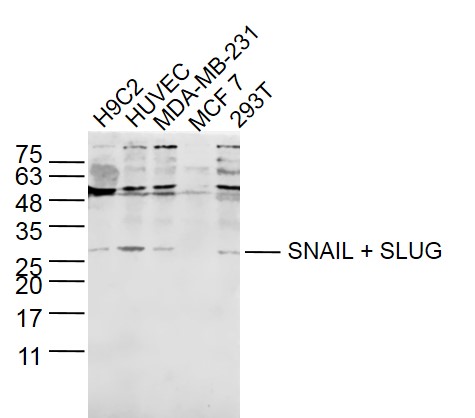
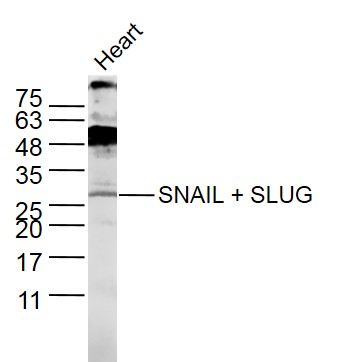
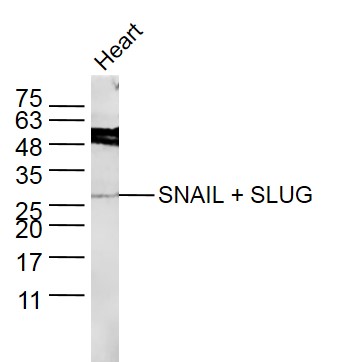
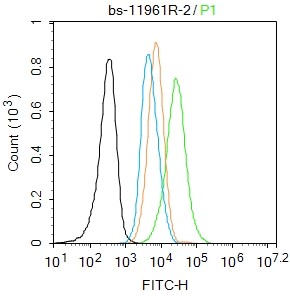
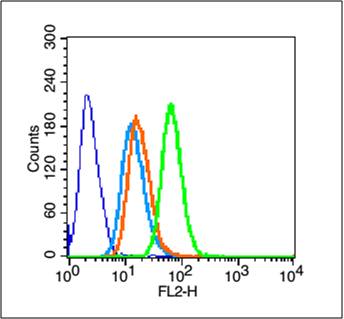


 +86 571 56623320
+86 571 56623320




